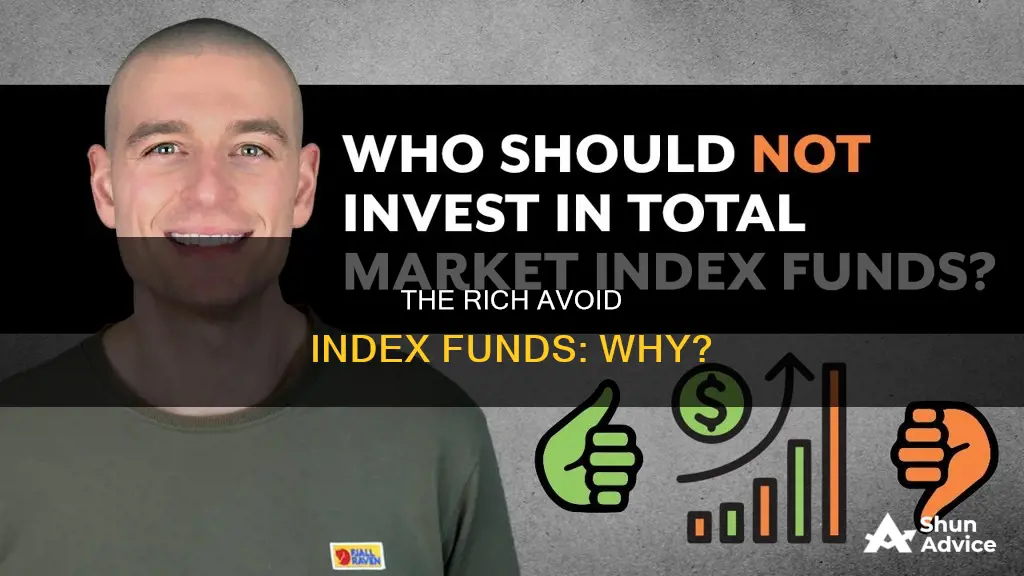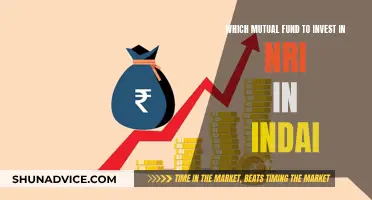
Index funds are a popular investment choice for those seeking low-cost, diversified, and passive investments. They are designed to replicate the performance of financial market indexes, like the S&P 500, and are ideal for long-term investing, such as retirement accounts. However, despite their many benefits, index funds are not particularly popular among the wealthy. This is because the ultra-wealthy may seek to invest in ways that offer them the opportunity to beat the market, even if it means taking on more risk.
Wealthy investors can afford to take on more risk due to their higher risk tolerance and often have the freedom to explore alternative investment options that are not available to the average investor. They may choose to invest in individual businesses, art, real estate, hedge funds, and other types of investments with high entrance costs and the potential for outsized rewards. These investments offer higher returns than index funds, which typically aim to match the performance of their associated indexes rather than surpass them.
Additionally, index funds offer limited flexibility as they are designed to mirror a specific market and cannot pivot when the market shifts. They also lack downside protection, leaving investors vulnerable during market downturns.
While index funds are a great choice for everyday investors, the wealthy tend to look for investment opportunities that offer the potential for higher returns, even if it means taking on more risk and paying higher fees.
| Characteristics | Values |
|---|---|
| Risk tolerance | The wealthy can afford to take more risk than the average investor. |
| Investment goals | The wealthy may seek to beat the market rather than match its performance. |
| Investment options | The wealthy can access exclusive investments such as hedge funds, private equity, and venture capital. |
| Investment costs | The wealthy can afford the high buy-in costs and fees associated with certain investments. |
| Investment diversification | The wealthy may have a minority of their portfolio in index funds, favouring other investments such as their own businesses, real estate, and collectibles. |
What You'll Learn

The wealthy can afford to take more risks
The ultra-wealthy, however, may seek to beat the market, even if that means taking on more risk. They have the financial freedom to take on more risk than the average investor, as a major loss would still leave them very wealthy. This allows them to explore riskier investments with the potential for higher returns, such as investing in individual businesses, art, real estate, hedge funds, and other types of investments with high entrance costs and high fees.
Wealthy investors can also afford the high buy-in costs and fees associated with these types of investments, which are often not available to the average investor. These investments offer the opportunity for outsized rewards, which is appealing to those with a high net worth.
Additionally, the wealthy tend to have a higher risk tolerance, as they can afford to take on more risk without jeopardizing their financial future. This enables them to pursue investments with the potential for higher returns, even if it means accepting more volatility and the possibility of losses.
In summary, the wealthy can afford to take on more risk, which leads them to explore alternative investment options beyond index funds. They seek to maximize their wealth and are willing to accept higher levels of risk to achieve their financial goals. This risk-taking behaviour is supported by their substantial financial resources, which provide a safety net in the event of losses.
Tax Managed Mutual Funds: When to Invest for Maximum Benefits
You may want to see also

They want to beat the market
Index funds are a passive investment strategy that tracks the performance of a market index. They are a great option for people who want to simplify the investing process and are generally a cost-effective, convenient investment choice. However, despite their benefits, index funds are not particularly popular among the wealthy.
One of the main reasons for this is that the wealthy often have a desire to beat the market and achieve above-average returns. Index funds are designed to match the performance of their associated indexes, rather than surpass it. The wealthy may not be satisfied with this, and may instead seek out investments that offer the potential for higher returns, even if it means taking on more risk.
Wealthy individuals can afford to take on more risk because they have a larger financial cushion to fall back on if things go wrong. For example, consider an individual with $400,000 invested in stocks for their retirement. If their portfolio declined by half, it would have a significant impact on their future quality of life. On the other hand, an individual with an investment portfolio worth $40 million could withstand a major loss and still be very wealthy. This allows them the freedom to take on more risk than the average investor.
In addition, the wealthy often have access to a wider range of investment opportunities that are not available to the average person. They may choose to invest in actively managed mutual funds, despite their higher fees and lower odds of outperforming the market. They may also invest in real estate, antiques, and other less liquid assets. They also have the ability to invest in hedge funds, which are generally not accessible to the average investor.
The desire to beat the market and achieve above-average returns drives the wealthy to seek out alternative investment opportunities that offer the potential for higher returns, even if it means taking on more risk and incurring higher fees.
Vanguard Funds: Gun Investments and Your Money
You may want to see also

They can afford high buy-in costs
Index funds are a popular investment choice due to their low cost, diversification, and passive management. However, the wealthy tend to favour other investment options despite the benefits of index funds. One reason for this is that the wealthy can afford high buy-in costs, which provides them access to exclusive and risky investments with the potential for high returns.
Wealthy individuals often have the financial means to invest in opportunities with high buy-in costs that are out of reach for the average investor. These investments, such as hedge funds, art, private companies, and luxury assets, offer the potential for significant financial gains. For example, hedge funds employ sophisticated strategies to beat the market, and while they come with high fees, they can deliver extraordinary returns. Similarly, investing in private companies or luxury assets like art and collectibles can lead to substantial value appreciation.
The ultra-wealthy are often willing to take on more risk in pursuit of higher returns. Their substantial financial resources allow them to absorb potential losses without significantly impacting their overall wealth. This enables them to explore riskier investments that may not be accessible or suitable for the average investor.
Additionally, the wealthy may seek to invest in areas that align with their interests and expertise. Many wealthy individuals have accumulated their fortunes through business ventures, so they continue to maximise their finances by investing in what they know best—corporate structures and market performance. They may also choose to invest in luxury assets that enhance their lifestyles, such as expensive cars, homes, or collectibles.
In summary, the wealthy can afford high buy-in costs, granting them access to exclusive and risky investments. They are more comfortable taking on greater risk due to their ability to absorb potential losses. Their investment choices are often influenced by their interests and expertise, such as business ventures or luxury assets. While index funds offer diversification and low costs, the wealthy seek opportunities that provide the potential for substantial financial gains, even if it means accepting higher risk and fees.
Golden Butterfly Portfolio: Best Funds for Long-Term Wealth
You may want to see also

They can tolerate higher fees
The rich can tolerate higher fees because they have a much wider range of investment opportunities available to them than the average investor. They can afford to sink their money into active investment funds run by the top talent in the industry, even if that means paying hundreds of thousands of dollars or more in fees.
Wealthy investors can also invest in luxuries such as art and sprawling real estate properties, which they can enjoy while benefiting from their increase in value over time. They can afford to take on more risk in their portfolios, which is often required for the opportunity to beat the market.
For example, while a $400,000 loss would significantly impact the future quality of life for an average investor, an individual with a $40 million portfolio can still afford to take on more risk. They have the freedom to pursue high-risk, high-reward investment opportunities without worrying about the potential impact of a major loss.
Hedge funds, which typically charge approximately 2% in fees and 20% of profits, are another popular investment vehicle for the wealthy. These funds require a high net worth for entry and use sophisticated strategies to beat the market. Despite the high fees, wealthy investors are willing to take on the risk for the opportunity to reap great returns.
In summary, the wealthy can tolerate higher fees because they have access to exclusive and diverse investment opportunities that offer the potential for higher returns. They can afford to take on more risk and are less dependent on steady returns, allowing them to pursue investments with higher fees that may lead to greater profits.
Tips Mutual Funds: When to Invest for Maximum Returns
You may want to see also

They can invest in less liquid assets
The wealthy have the financial freedom to invest in less liquid assets. They can afford to take on the risk of investing in real estate, antiques, and other less liquid assets. For instance, the average investor probably cannot afford to take on the risk associated with buying a $50,000 piece of art with the hope that it will appreciate in value.
Wealthy investors can also put money into hedge funds, which are usually off-limits to the general public. These funds require investors to demonstrate a high net worth, typically $1 million or more, and they aim to beat the market using sophisticated strategies. While they charge high fees, wealthy investors can afford to take this risk in the hopes of achieving extraordinary gains.
The ultra-wealthy may not be satisfied with the performance of index funds, which generally aim to match the performance of their associated indexes rather than surpass it. They may instead seek out investments that offer the opportunity to beat the market, even if that means taking on more risk.
The wealthy also tend to have a large portion of their wealth tied up in their own businesses and other business ventures. They may own businesses they have started or aggressively invest in private growth companies through venture capital funds. This allows them to have more control over their investments and take advantage of their expertise in specific industries.
Overall, the wealthy have access to a wider range of investment opportunities and can afford to take on more risk, which may lead them to favor less liquid assets over index funds.
Strategic Timing for Long-Term Bond Fund Investments
You may want to see also
Frequently asked questions
The wealthy tend to look for opportunities to beat the market, even if that means taking on more risk. Index funds are designed to match the performance of their associated indexes, not surpass it.
Index funds are a low-cost, convenient, and diversified investment choice. They are passively managed, meaning managers aren't actively buying and selling much to keep fees low. They are also transparent, with holdings that are well-known and available on almost any investing platform.
One of the main drawbacks of index funds is their lack of flexibility. They are designed to mirror a specific market, so they decline in value when the market does and can't pivot when the market shifts. They also lack downside protection, leaving investors vulnerable during market corrections and crashes.







